Samsung NU8000 Review
The Samsung NU8000 is a TV model from the 2018 TV lineup, with firmware updates up to 2020 and a mid-range device in the upper-performance range. It came on the market in the second quarter of 2018 and has since become one of the more popular Samsung TVs in the sales ranking.
What are the advantages and disadvantages of Samsung NU8000? Is it worth buying a Samsung NU8000? What are the alternatives? The article helps you with your purchase decision.
We reviewed at the model UE55NU8000 with a 55-inch screen diagonal and 100 Hz panel. The results can also be applied to models with other screen sizes (UE49NU8000, UE65NU8000, UE75NU8000, UE82NU8000).
Pros And Cons Of The Samsung NU8000
Pros And Cons
Pros
- Good color representation, wide color space coverage.
- Low input lag (around 20ms) good for gamers.
- Despite Edge LED technology, black is very dark and the contrast is high (VA LCD panel).
- Good equipment including Smart Remote, PVR, double tuner, etc.
- RGB panel can also be used as a computer monitor.
Cons
- Low viewing oblique angle. Not suitable for home theater arrangements with more than three viewers. Viewing from an oblique angle shows some washed-out colors.
- Lack of support for the DTS audio codec and DivX video codec.
- No analog or legacy connections, so if you require one, you have to use a DAC.
- The 49-inch version only has 50Hz instead of 100 Hz
- (2020 update) Bixby does not function as smoothly as Google assistant or Alexa
Difference Between Samsung NU8000 And Samsung NU8009
The Samsung NU8000 is the model for the United States and the Samsung NU8009 is the model for the European Union. They are exactly the same model except for three differences. European models have a longer warranty according to European regulations where consumer protection is very strict.
Furthermore, in the Samsung NU8000, you cannot switch off the notifications and ads in the Tizen environment. In the European model, the user can switch them off because a consumer may not be forced to receive advertisement as a condition to utilize a technology environment (such as proprietary OS Tizen 4) or a device (such as the Samsung NU8000 or 8009 itself).
Ergonomics And Design Of The Samsung NU8000
The 360 ° design of the TV can only be described as successful. It is not only stylish but also practical. A very thin border and the minimalist base put the modern technology of the screen in the foreground. The cables can be routed from the connections on the back to the base, through which they then run away to the rear. This always helps to make a tidy impression.
The casing design of the Samsung NU8000 looks very classy. The frame is only a few millimeters thin. The picture then only starts at a distance of about 9 millimeters from the outer edge, but the TV still makes a well-designed impression. When switched off, the edge looks very thin and only a few millimeters wide. The edge of the case is made of metal and black. The workmanship is very good, the gap dimensions are all equally pronounced and there are no sharp edges.
The base is set in the middle and represents a large T. It is mounted in the lower area on the back and also serves as a guide for the cables. Here Samsung has found a good solution for the tangle of cables. The color of the base is silver and black and it is largely made of plastic. There is a metal plate on the underside of the foot, which gives the device the necessary weight for stability.
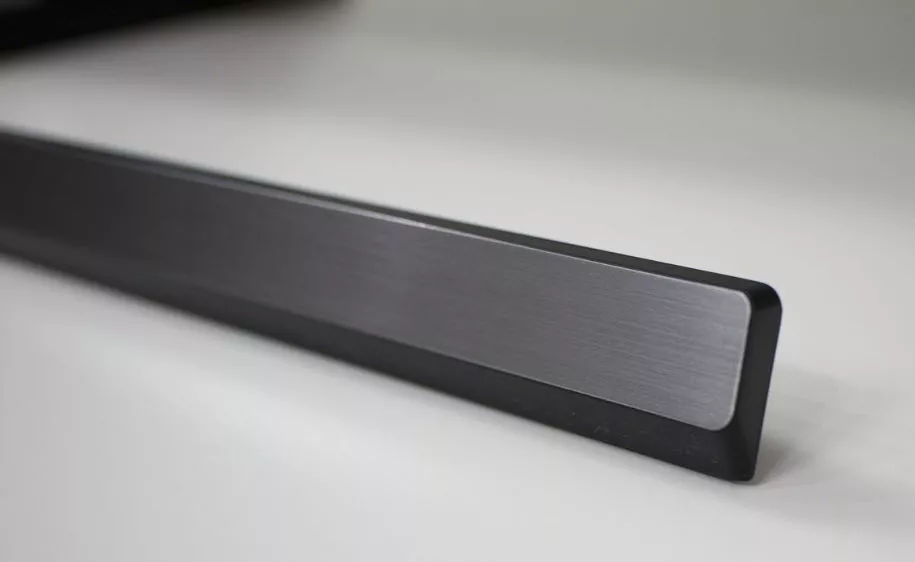
THE STAND IS EASY TO INSTALL.
The stand itself cannot be swiveled. Tilting forward and back is reliably prevented. If you push the pages up and down, you notice a slight instability, which usually does not have a disruptive effect in everyday life. The Samsung UE55NU8000 is significantly heavier than the simpler model NU7179, which is due to the more metal used.
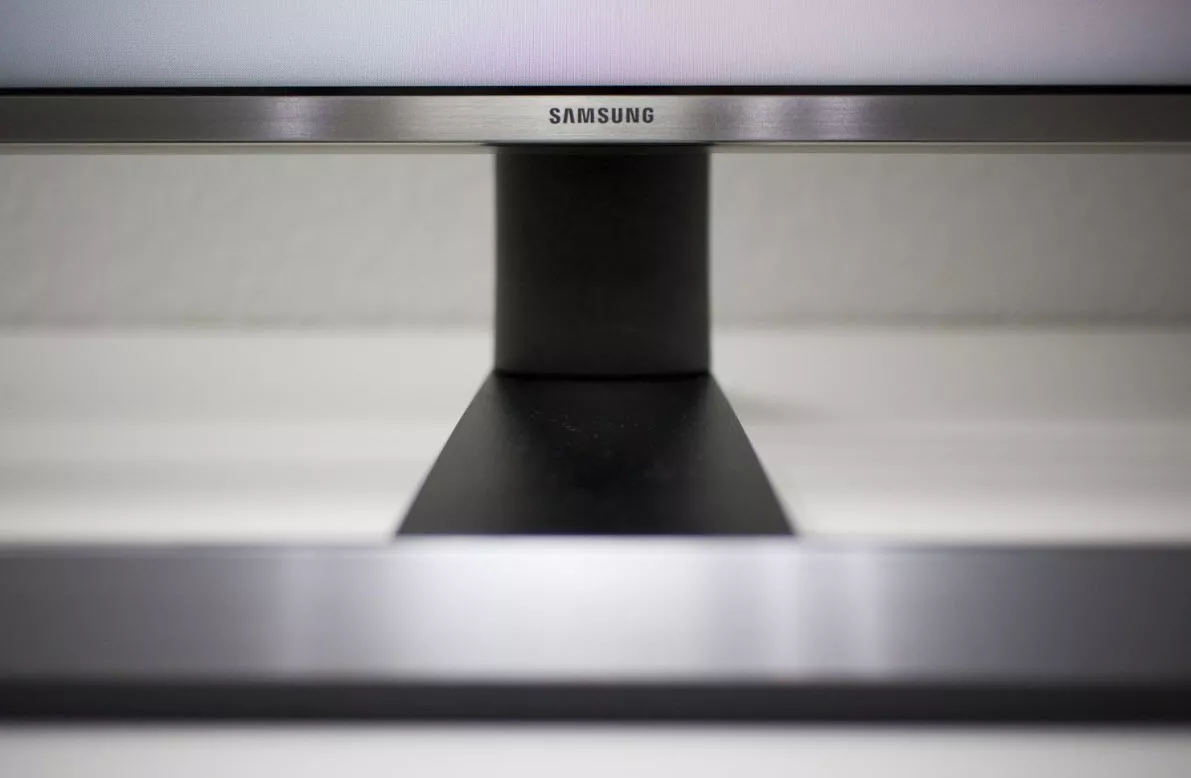
The back of the case is made of plastic and has horizontal stripes.
In the lower area, there are “notches” for the cable routing over the entire rear of the housing. Samsung has introduced this solution in all new TVs and is very practical. When viewed from the front, the connections are on the right-hand side and are all accessible from the side. Wall mounting works so easily.
The TV comes well packaged and an assembly of the 55-inch version would theoretically also work with one person, but two people are better who can tackle the panel together on the underside according to the instructions. The box has a perforation so that it can be lifted out without problems and can be worked without sharp objects.
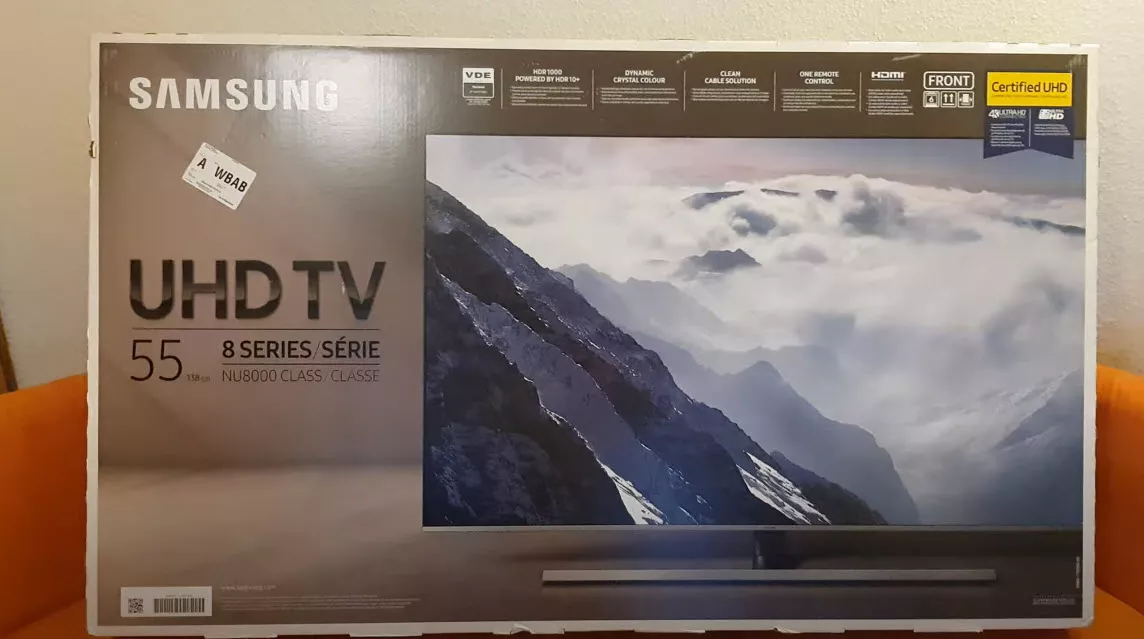
The Samsung NU8000 is a joy to look at. It actually looks like something an interior designer would pick out. At 0.4 inches, the black bezels at the top and the sides of the TV are nearly invisible. The same goes for the silver trim that frames the bottom edge of the TV.
The black-and-metal TV stand looks just as good as the rest of the TV. Then there is the back of the TV, which has a textured, matte-black finish with cable tracks that run along its length. There is an input panel at the lower-left corner, just above one end of the tracks.
This Samsung NU8000 comes in a classy design in black and silver. The thin case edge, which only shines a few millimeters when switched off, is an eye-catcher. The stand offers sufficient protection against accidental tipping.
Picture Quality
Let me start by saying that the picture quality of the Samsung NU8000 is excellent. However, there is a small size-specific difference. The 49-inch version only has 50Hz instead of 100 Hz.
Unfortunately, the colors change quite quickly with increasing viewing angles. The successful semi-gloss finish in turn reduces reflections and blurs them slightly. If you are sitting in front of the television, you can fully enjoy the immense colors of the 10-bit screen.
With deep black from the VA display, dep black that reminds us of the iconic Pioneer Kuro, the device can produce large contrasts (~ 5000: 1). Local dimming and edge LED backlighting could be better. In normal scenes, there is a brightness maximum of approx. 500 nits.
The panel of the Samsung NU8000, as has been common for a few years, shows the UHD resolution with 3840 x 2160 pixels. The Samsung NU8000 is part of the middle-class segment of Samsung and has a panel with a native refresh rate of 100 Hz. This enables crisp, sharp images even with fast movements. However, the 49-inch version of the Samsung NU8000 (UE49NU8000) only has a 50 Hz panel installed. With many models in 49 inches, unfortunately, the large manufacturers are now making major cuts.
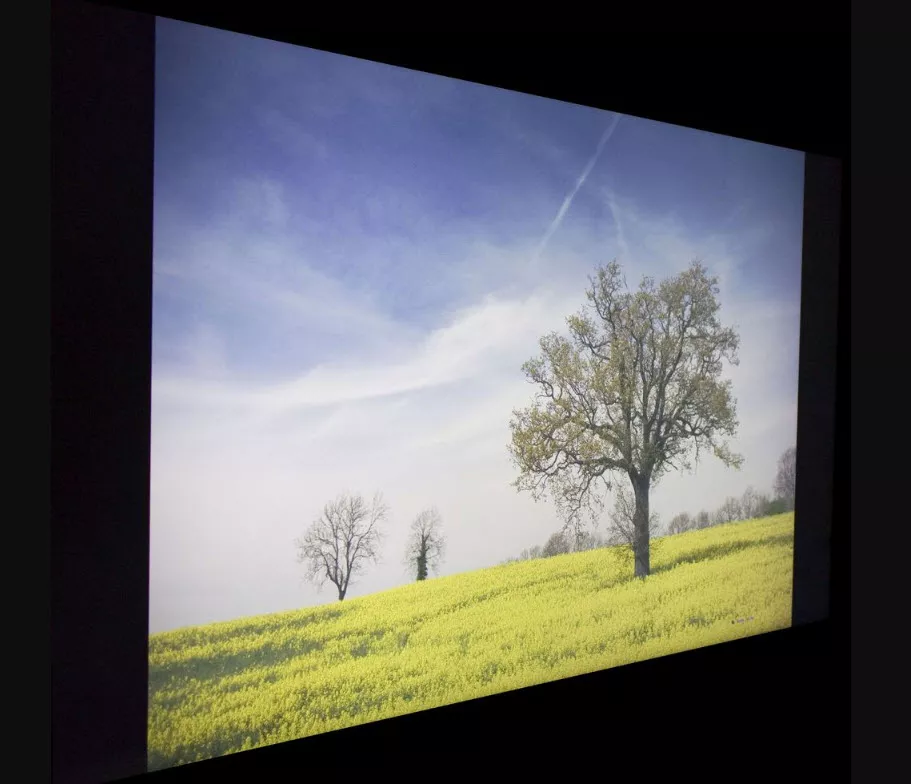
AMPLE VIEWING ANGLES IN THE Samsung NU8000
The panel itself can display 10-bit color gradations and is therefore well suited as an HDR television. Compared to older models with 8-bit color gradation, there are no more levels to be seen here. The color depth of 10 bits (or the color gradations with 10 bits) is achieved via an 8-bit panel with FRC technology.
The panel is based on vertical alignment LCD technology (VA-LCD) , which has advantages and disadvantages. The advantage is the high contrast ratio of the image, which is typical for the Samsung NU8000 with approx. 5500: 1 VA LCD. Black actually stays black with a VA LCD and does not fade to gray like with an IPS panel. VA-LCD technology also has a disadvantage: you get an optimal picture when you sit in the middle of the TV. If you look at the picture from the side, the colors look washed out, the further you move to the side. The dependence on the viewing angle can be seen very well in our example: the colors become lighter when viewed from the side, the green of the tree fades, the flower meadow is no longer bright yellow. The black border shows that it turns gray. That makes IPS-LCD technology better.
The peak brightness was measured by rtings.com with approx. 800 to 850 cd / m² in SDR and HDR mode. The Samsung NU8000 thus creates decent peak brightness for HDR content and leaves only a short distance from the magical 1000 cd / m² limit, which is covered by Samsung’s premium class QLED. Don’t be fooled by the HDR1000 imprint on the box. In reality, the peak brightness is usually below the specified value.
The color space coverage is good for the middle class: with 86% in the DCI-P3 and 63% in the Rec. 2020 color space, the Samsung NU8000 can display many colors and thus create a natural color impression.
The default settings for the image or the color settings are too gaudy in standard mode. The film mode is better, which looks a bit matt and darker, but better matches the color rendering and color temperature. This works through the setting in the menu. You should also make sure that the color temperature is “Warm2”. So you get very good picture settings for your Samsung NU8000 directly with just a few settings. “Very good picture settings” here means that the film is presented as the producer intended. Ultimately, however, these are individual preferences. If you look at the picture mode Dynamic then you can, of course, choose this one too. There the picture is usually too cold and the colors overdriven. We carried out the different image modes with an HDR test pattern.
Black is good on the Samsung NU8000. The picture is very homogeneous in our example and has no clouding or backlight bleeding, although the backlight is an edge LED and no direct LED screen. The Edge-LED backlight has the local dimming property so that the TV with the LED bar in the lower edge can dim in columns.
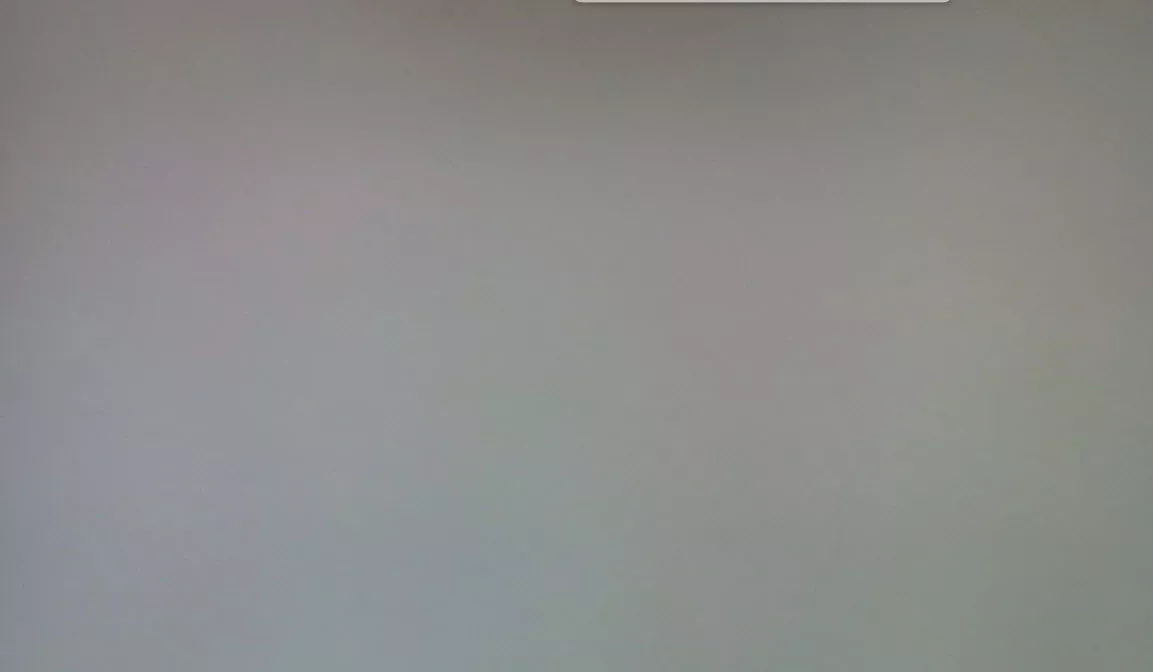
GRAY DISPLAY
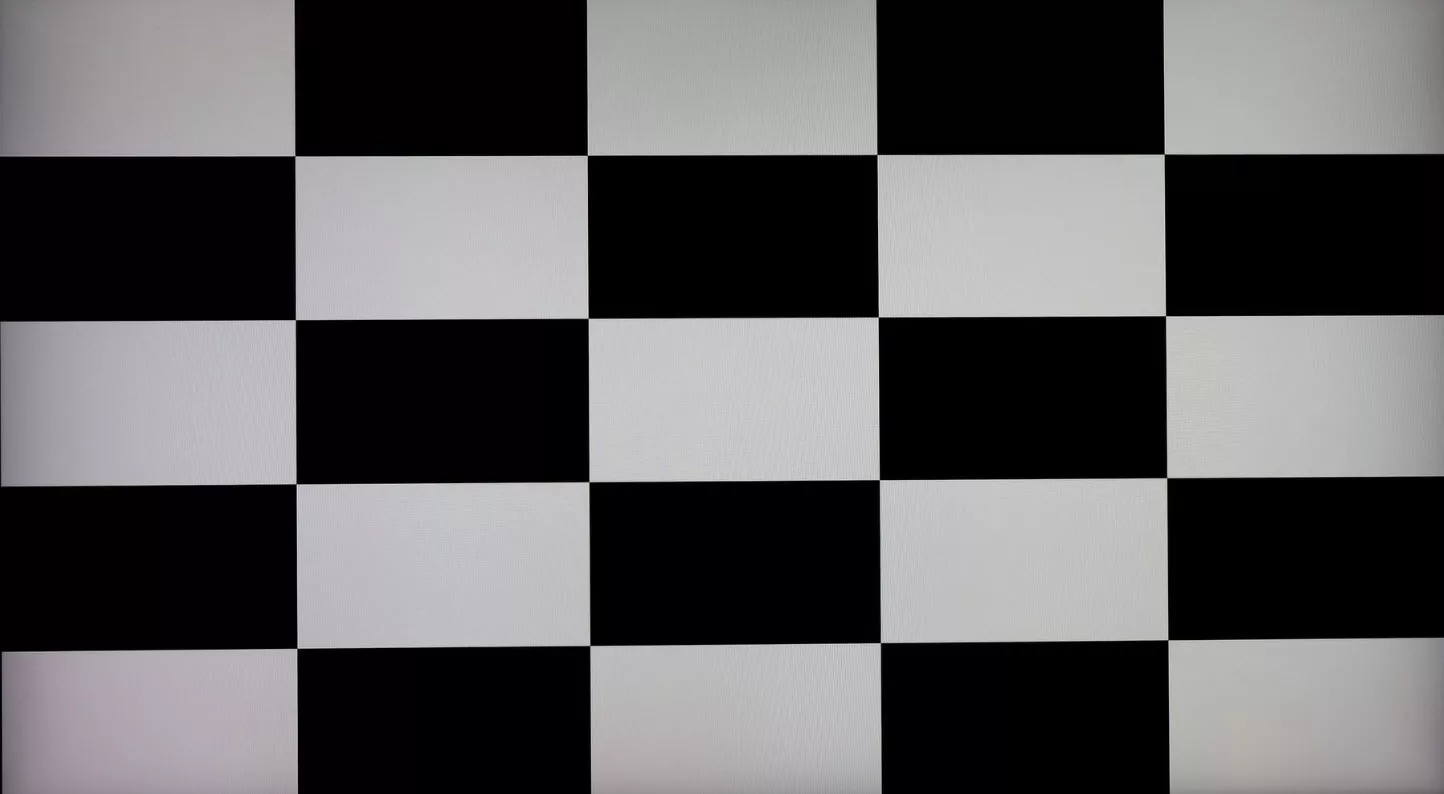
CONTRAST CHECKERBOARD
For an even sharper display of fast images, you can activate the Auto Motion Plus function in the menu. Black frames are introduced into the video stream, which ensures that the eye or brain gets a better impression of sharpness. Many will find flicker a disadvantage, which is not inevitable with this technique.
In addition, the picture becomes darker. We all find the flickering uncomfortable, so this option remains switched off.
As is typical for Samsung, the panel itself has an RGB pixel structure. Each pixel consists of the colors red, green, and blue and can be controlled individually. LG now uses RGBW panels in many of its mid-range televisions. The RGBW panels can display bright images, but the color resolution drops because not every pixel can display all colors. The Samsung NU8000 can also display text crisp with the RGB panel, so that the TV can also be used as a monitor on the computer, for example for text.
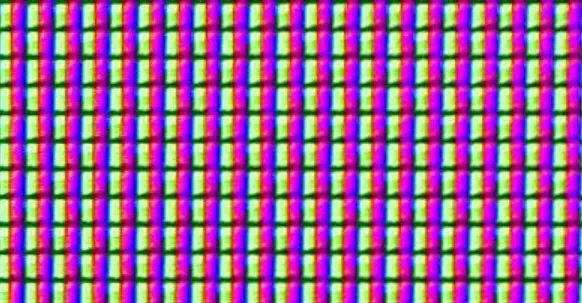
PIXEL STRUCTURE
The image quality of the Samsung NU8000 is very good for the middle class. It creates a high color space coverage (at an affordable price) and displays black very well (compared to IPS TVs). The viewing angle dependency remains the big shortcoming of the VA-LCD technology, but only disturbs when you look at the screen from the side. Otherwise, you get a very balanced picture with good coordination without large settings with the film image setting.
Input Lag And Gaming Suitability
The Samsung NU8000 can handle fast movements pretty well. The response time is very short and the input lag is always surprisingly low in the “game mode”. Depending on the type of input signal, it is on average 20ms (see chart below). However, there are measurements sampled between 10 and 18ms. Of course, you have to switch to game mode, otherwise, you will have an input lag of about 80 to 85ms. The possibility of 120Hz input is particularly interesting for PC users.
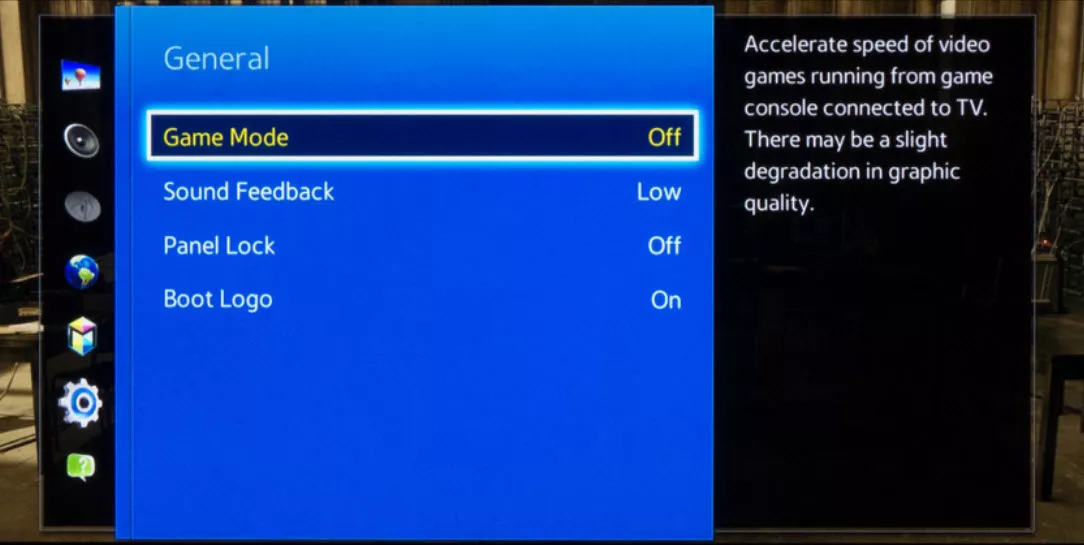
The latest firmware update even includes FreeSync, which enables a variable refresh rate (VRR). This means that the frequency of the TV can be adjusted to the frames per second (fps) of the input source.
Computer and console games on the big screen are a lot of fun. The newer game consoles like the Playstation 5 and the Xbox One S and Xbox One X are now also transmitting UHD resolutions and HDR meta information to the television. The Samsung NU8000 can process these output formats from the consoles and thus displays razor-sharp game graphics (if the console is ready).
However, not only the graphics are important for a good gaming experience, but also how quickly the TV and the console react to inputs. As a rule, every newer television that has an image processor has a delayed display of the image. The delay is called input lag. If the input lag is too large, i.e. the image is shown on the display much later than it was output by the console, the game feels stiff and uncontrollable. In the case of jump and run games, for example, this means that you run into obstacles because you supposedly pressed “jump” too late.
The input lag has been continuously optimized by the major manufacturers in recent years. Coming from over 40-50 ms, Samsung has now reached about 20 ms with the Samsung NU8000. This is completely sufficient for fast games and most of them will not notice any annoying delays.
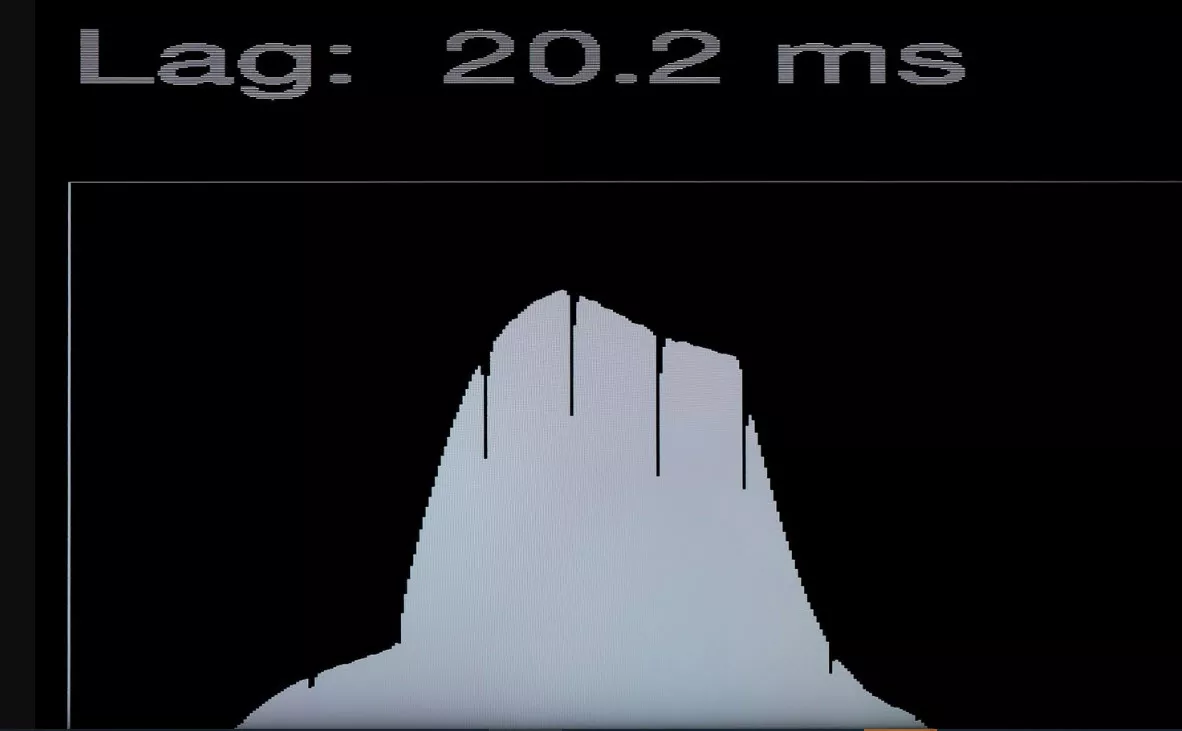
INPUT LAG IN GAMING MODE IS QUITE LOW. HERE THE LOWER, THE BETTER.
With Freesync technology, Samsung is currently the only TV manufacturer to be able to further reduce the input lag in 2020.
Freesync technology does not require to pay any additional license (G-Sync technology requires a license), so your television or monitor with Freesync is cheaper just as a computer with Linux is a bit cheaper than the same computer with Microsoft Windows.
With Freesync, the console or PC coordinates with the television via HDMI to certain parameters of the connection (the transmitted refresh rate). Freesync aims to avoid screen tearing. Freesync enables the Samsung TV to process the signal “faster” and pass it on to the panel. The result is an input lag of around 7-8 ms, which means a clear halving of the input lag time.
It is important for all game options that the gaming mode is switched on. Some image enhancers are switched off in this way. The input lag in film mode is approx. 80 ms, which is already clearly noticeable when playing but fine for watching films.
If you are planning to purchase an Xbox One X, Xbox One S, or AMD graphics card with Freesync or already have one at home, you will be happy about the Freesync option on the Samsung NU8000 on Samsung TV.
The Samsung NU8000 is therefore very well suited for fast games in gaming mode because the input lag in game mode is very low at 20 ms. With appropriate compatibility, the input lag can be reduced to 7-8 ms with Freesync.
Sound Quality
At first glance, the slim housing is unlikely to sound good. However, the sound from the 2.1 channel system with 40W comes across clearly. The bass is also unexpectedly powerful. In any case, it is sufficient for the everyday program.
The internal speakers are fine, but if you really want to have surround sound, you can connect it to other external speakers like a Bluetooth Devialet, or a bookshelf speaker like the B&W 805 D3, or a ProAc Response.
The Samsung NU8000 has a 2.1 channel system with a total of 40 watts. In addition to the stereo speakers, a subwoofer is integrated, which ensures a lower tone and better covers the lower frequencies of the audible range. From the output power and the dimensions of the TV, you can already deduce that the subwoofer does not have an 8-inch woofer. Nevertheless, the sound sounds clearly fuller and bass shimmer through.
In a direct comparison with the entry-level device Samsung NU7179 with two stereo speakers, the sound of the Samsung NU8000 sounds much better. Samsung has managed to increase the sound quality despite the flat dimensions of the TV.
An external soundbar with a corresponding subwoofer increases the sound quality again in any case. In contrast to the NU71719, the Samsung NU8000 can also be connected wirelessly via Bluetooth as we explained before.
From our point of view, a major shortcoming of Samsung’s entire TV lineup 2018 is the lack of DTS support. Samsung has removed the DTS decoder from all TVs in the 2018 line-up (based on licensing costs). Dolby support is still available, but there are still many sources with a DTS soundtrack.
Where is DTS support missing?
Whenever the TV should directly decode a DTS soundtrack and output it via the loudspeakers, an error message “ Unsupported functions ” and “ This audio file is not supported. “. The message can be acknowledged with OK or stop. If you press OK, the film continues silently. When stopped, the movie stops playing.
DTS soundtracks can be present on DVDs, Blu-rays, streaming content, and your own films. As a result, the integrated media player from Samsung, which was an “omnivore” in the past, no longer plays DTS soundtracks (also no DivX films). You have to decode the sound from another device and have it converted to a different format (e.g. an HTPC, if available). Alternatively, the soundtracks of the film collection can be converted into other formats with more or less effort. Since only the audio track is affected, this is faster compared to completely re-encoding the video track. Still an annoying limitation.
The sound of the Samsung NU8000 is good with the integrated subwoofer and sounds full. The lack of DTS support will be a shortcoming for one or the other buyer, which could have been easily (but probably costly) avoided. If you have the option of transcoding ad hoc or in advance, this is no longer an obstacle.
Connections
On the back of the Samsung NU8000, you can find all relevant digital connections accessible from the side. There are neither analog nor legacy connections on the Samsung NU8000. If you still have analog devices that you want to connect, you have to use a digital-to-analog converter. This worked fine and we tested with the Elgar Plus and the Schiit stack, where one of the modules of the stack is an entry-level DAC (Schiit Modi 3). Also, you can connect it to the McIntosh MA9000 that also has DAC functionalities.
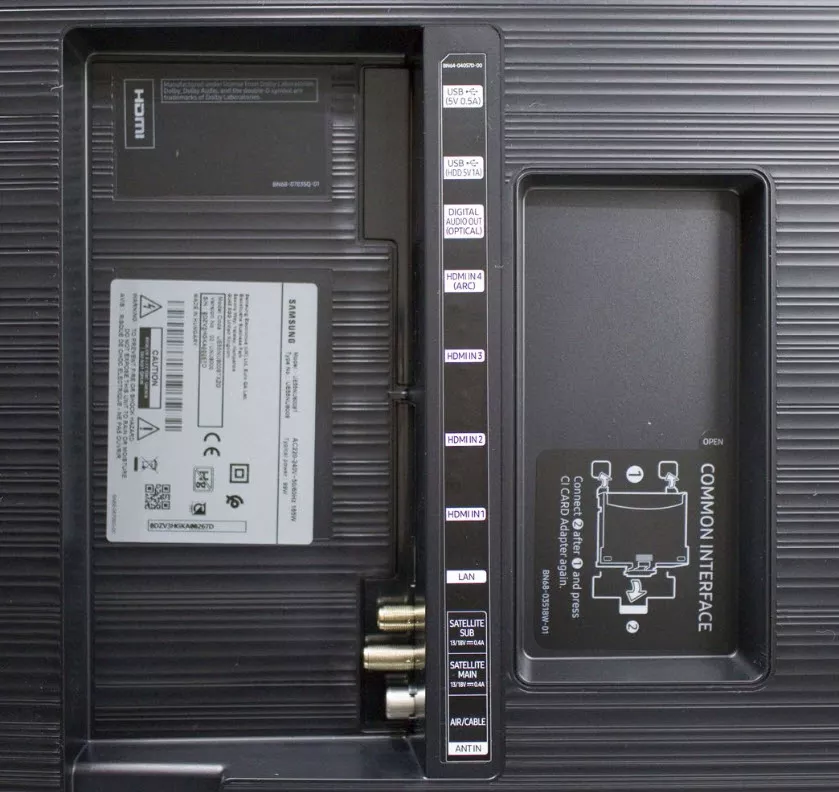
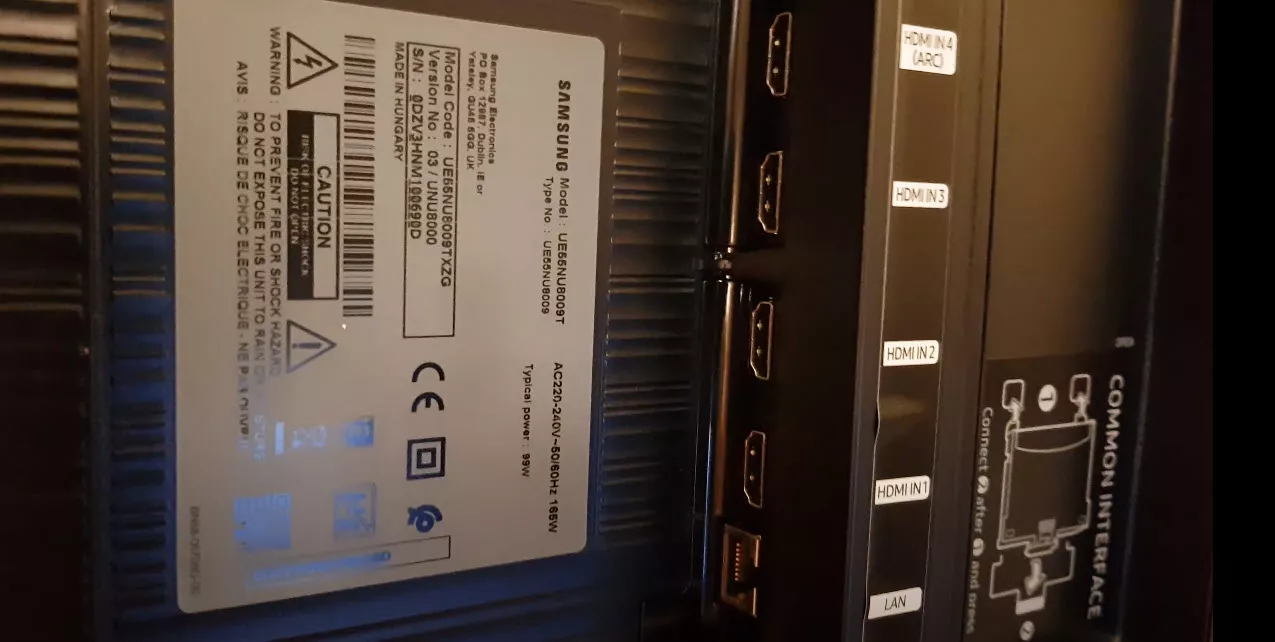
The connections include:
- 4 x HDMI, HDMI-4 with Audio Return Channel (ARC)
- 2 x USB
- 1 x CI + slot (sticker must be removed)
- 1 x digital optical audio output
- 1 x Ethernet
- 2 x satellite and cable (2 x DBV-T2 / C / S2 tuner)
- WLAN
All the input ports are held in a left-facing side panel on the left side of the TV. The panel holds two USB ports, an optical audio port, four HDMI ports, an Ethernet port, an RS 232 connector and an antenna input.
The TV does not have, and it is important to remark it, the legacy AV ports that you will find on many televisions. That means that you cannot hook up that DVD player that you put away.
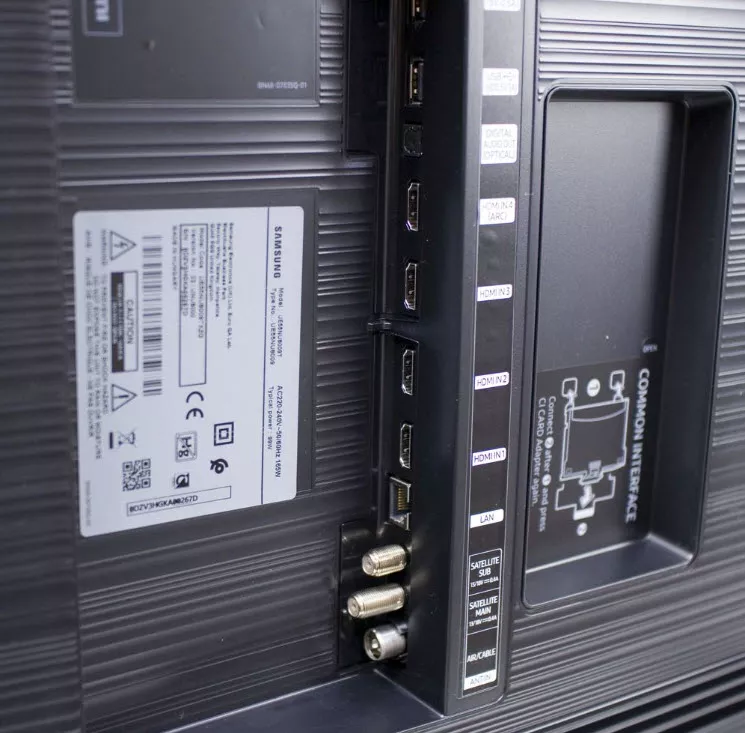
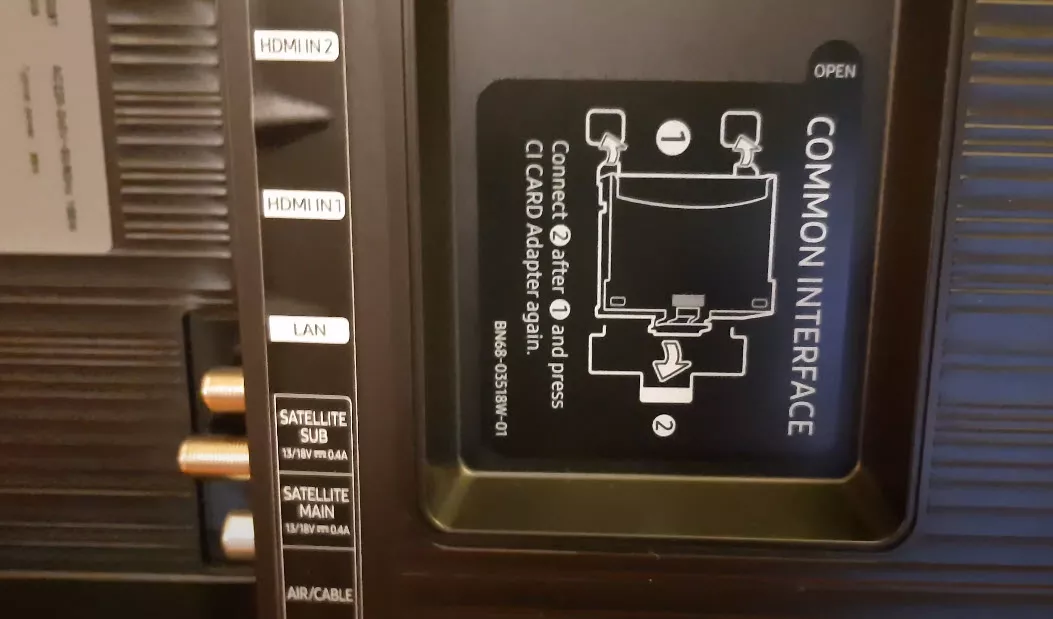
Bluetooth Connectivity
The TV can log into a WLAN wirelessly and a connection via Bluetooth is also possible. Incidentally, the Samsung Smart Remote also works via Bluetooth, so it does not need a line of sight to the TV. We connected a Devialet speaker here via Bluetooth.
AV Receiver Connectivity
It is perfectly possible to connect the Samsung NU8000 to a receiver and create your own arrangement using the receiver as a hub.
For example, you are playing a game in Playstation 5 and connect it through an AV receiver that forwards audio to a loudspeaker and video to this Samsung NU8000.
Here I would recommend all devices that passed well our reviews and are efficient. You can use a receiver as the Onkyo TX-NR686 or an entry-level Denon X2500H that is a bit old but can be found very cheap. I will not recommend the also entry-level Denon X2700H because you are paying too much for an 8K functionality you will not use as this Samsung NU8000 cannot output 8K video.
Equipment And Features
Like the previous model, the Samsung NU8000 also benefits from intuitive voice control with the Smart Remote. The all-encompassing smart home solution from Samsung, smart things, is new. With this, any networked device can be controlled on the TV via Smart Remote. Delayed television and USB recording are also no problem.
The equipment features of the Samsung NU8000 are diverse and are partly borrowed from the “premium range”.
The Smart TV operating system Tizen 4.0 (We tested with the 4.0.0.7) is very easy to use with the Smart Remote and responds briskly in our test, we did not experience crashes in the Smart TV system with a restart of the TV. The interface is intuitive and quick selection options are available for some parameters.
The Samsung NU800 runs the manufacturer’s operating system, the Tizen. It has a simple, intuitive interface and Samsung’s well-stocked app store.
One downside of the interface is that its animations lack smoothness. You will notice that animated elements of the interface tend to move like a really fast slideshow. Every now and then, you will see ads and notifications appear on the interface. You will be unable to shut them off in the Samsung NU8000 (only in the European NU8009 they can be switched off).
The Tizen interface comes with its own voice assistant named Bixby, who will help you when you cannot or will not use the remote buttons.
The double tuner with 2 x DVB-T2 / C / S2 already mentioned in the connections enables the simultaneous recording and viewing of two different transmitters, which would not be possible with a single tuner. The recording function (PVR) requires a connected compatible hard drive or a fast USB stick. When connected for the first time, the TV performs a hard drive performance test to determine whether it can be read and written at the appropriate speed.
The picture-in-picture function can also be used with the double tuner. So you can have two TV channels displayed in the main window and in a smaller window, whereby of course only the sound of one channel is output. Changing channels works with the Smart Remote in both windows without any problems. Of course, the display of an HDMI input also works, so that you can, for example, watch a film and run a sports channel in small side by side.
The relevant Smart TV apps are available in Tizen and additional apps can be installed. Amazon Prime, Zattoo, Youtube, and Netflix are available as streaming apps, for example. HbbTV of the media libraries can be used in exactly the same way if the television is integrated into the home network or the Internet.
The Electronic Program Guide (EPG) is quickly available from Samsung and easy to navigate. The integration of the remote control and the explanation of the functions using a pictogram in the upper part of the program guide are nice.
The Samsung Premium Smart Remote is a remote control that has only a few buttons, some of which have two functions. Samsung wants to bring simplicity to the remote control and get away from the remotes with many buttons.
In fact, the main functions are all quickly accessible and have dual functions. Volume and program are rockers that can be pushed up and down. Pressing the button itself silences the TV and the program calls up the EPG Guide. This is a good solution. Functions that cannot be operated directly via the remote control must be called up via the menu or the settings. For example, you always have to activate the PiP function via the main menu, which can be reached via the home button. The small hole in the upper area of the remote control is intended for the microphone so that you can also give voice commands to the TV with the existing Internet.
The Premium Smart Remote connects via Bluetooth and is ready to use right from the start. In our view, the control pad on the Smart Remote is a little too high on the remote control. Compared to the LG Magic Remote, we haven’t really gotten used to the position of the D-pad even after many times of use and sometimes we still have to reach around or look.
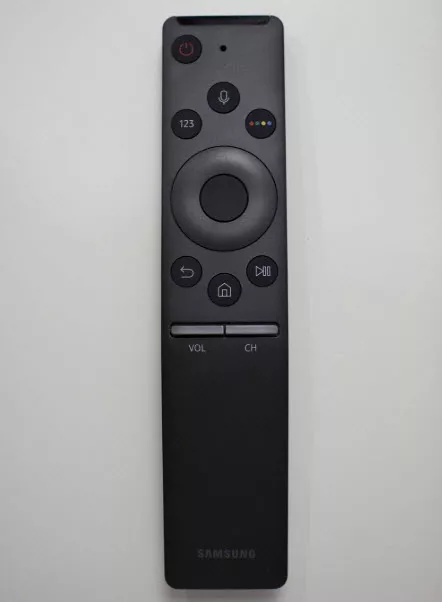
The Samsung NU8000 offers a lot of functions like an integrated video recorder, a media player, a double tuner, and a smart TV system that can be operated quickly. There should be nothing left to be desired for those interested in TV. If you want more (such as Ambient Mode) you have to use the QLED series.
Assembly and Initial Setup
The bracket and the base are packed separately and can be easily installed using a screwdriver and four screws. The assembly can be done on a large table or on the box itself and is usually done with the necessary care in a few minutes.
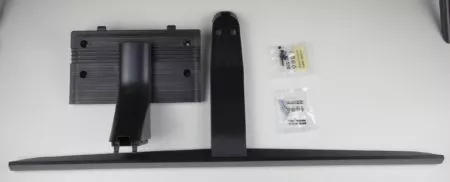
Once you have brought the TV into its correct position and connected and laid the cables, the last thing to do is to place the cable cover over the rear part of the stand and have a clean cable guide. A very good solution from Samsung, which fortunately has also put a lot of emphasis on it in recent years.
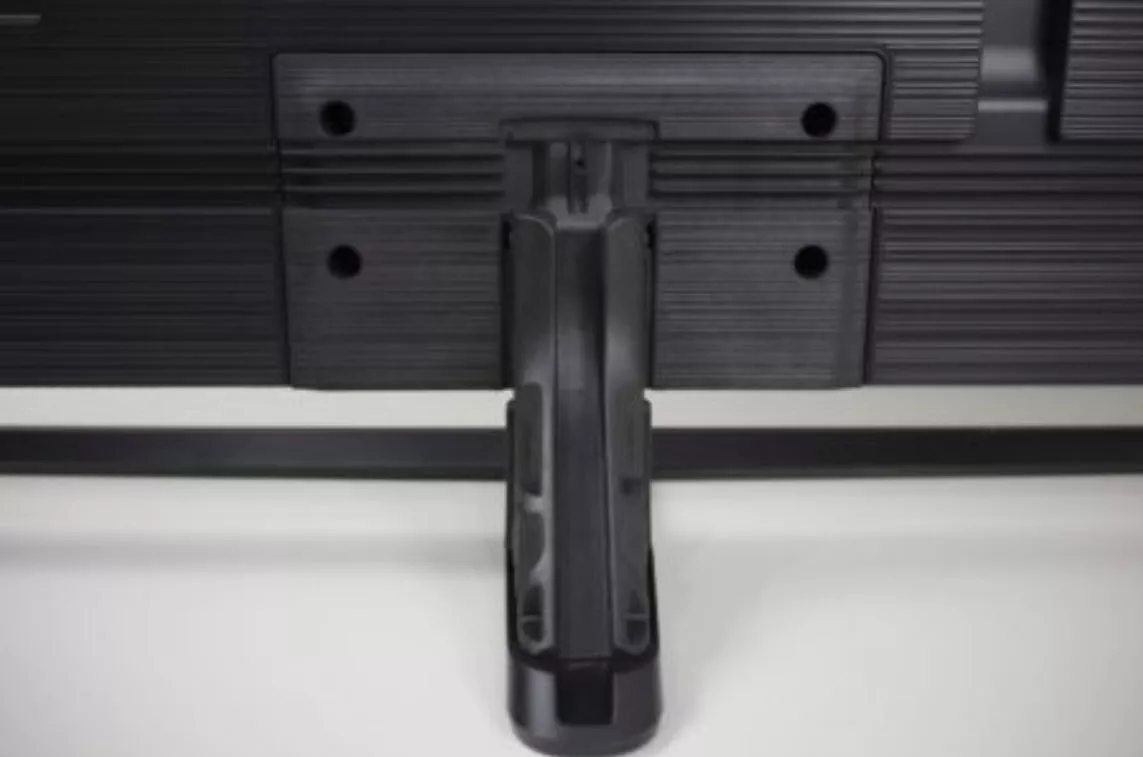
The initial setup is very simple and assistant-based. The search for the cable transmitters (in our example) runs very quickly and you are guided through the menu through the network setup and other. If necessary, all settings can still be made later using the settings menu.
Alternatives to the Samsung NU8000
What are the possible alternatives to the Samsung NU8000?
The next better model to the Samsung NU8000 from the QLED series is the Samsung model Q6FN. The Q6FN comes with a higher color space coverage and is slightly more expensive with the same screen size. The design is also slightly different.
An alternative at LG is the SK8000 or SK8100. These models from LG also have a good color display thanks to the nano cell display, a 100 Hz panel, and an easy-to-use Smart OS with WebOS 4.0. A relevant difference is a panel used: LG has an IPS panel in the SK series, which has advantages and disadvantages. The SK8000 and SK8100 TVs discussed here also have Edge LED backlighting.
If you prefer a Sony TV because of the good image processor, you can take a look at the XF series and there specifically the Sony XF8505. This also has a 100 Hz panel. Even better is the XF9005 with its FALD backlight.
Conclusions: Is The Samsung NU8000 Worth It?
The Samsung NU8000 series is a mature successor to the successful 2017 MU8000 series. If you exclude the slower 49-inch model, you have to deal with very fast, color-intensive screens. Great for gaming, but also perfect for daytime television in bright rooms. Even when enjoying home cinema in darkened rooms, it outperforms most competitors from the same price range. However, the big shortcoming of the VA panels remains; that you can hardly see them from oblique angles. If you often plan to watch with more than two to three people, it is better to use the IPS devices from LG or Sony.
From the 55 inch version, the Samsung NU8000 is a great all-round device with very good features at a fair price. The 49-inch version is delivered with a 50 Hz panel, which limits the image quality with fast movements. No matter whether in a bright or dark room, the Samsung NU8000 presents good colors and a deep black. Of course, it is better with a FALD television (Full Array Local Dimming) or with an OLED TV. And also of course, these are also significantly more expensive.
A shortcoming in our view is the lack of support for DivX and especially DTS, which could prevent some from buying. For most buyers, however, the lack of support doesn’t matter. In addition, the image deteriorates when you look from the side, so you should rather use an OLED or IPS panel in such circumstances.
The TV is well suited for gamers due to the low input lag and the picture quality. No matter whether HDR or SDR content, Full HD Blu-rays, UHD Blu-rays, and 4K streams, the Samsung NU8000 displays the content well.
Further Readings
We have some other interesting articles for you to read, we have selected our top articles below, and tried to keep this list short.
We have a technical vademecum where we discuss industry terminology and how it can be useful for you. Selected examples are the definition of PCM audio, then comes the comparison between PCM and Bitstream, the comparison between DTS Neo 2.5 and Dolby Digital, and the process to match amplifiers to speakers.
Also, we have reviewed some interesting DAC: The Elgar Plus from dCS, and the Schiit stack. where the Modi 3 behaves as an entry-level DAC.
In our reviews of AV receivers, we can recommend you to read some of our favorites, the ones that we liked the most, and trying to make the list short, we have the Denon AVR-X2500H, the Onkyo TX-NR686. We also have reviewed completely the Denon 8K receivers where we have studied the 8K Denon AVR-X2700H, the Denon AVC-X6700H, the AVC-X4700H, and the AVC-X3700H.
If you are into amplifiers, my favorite is the McIntosh MA9000, and that is why I would like to recommend you to read that review. My second favorite amplifier is the Mark Levinson 5805.
Regarding speakers, we have reviewed tiny bookshelf-speaker devices to large towers. My favorites were: the Devialet Gold, the Devialet Silver, the ProAc Response DT8, the Bowers and Wilkins 805 D3,
We do not review many headphones, but if you want a Sennheiser headphone for less than 100 dollars, we have this Sennheiser HD595 review.
We have some TV and monitor reviews and here we recommend the Samsung NU8000 (for gamers!) and my favorite is the review of the classical Pioneer Kuro.
Our home theater aficionados want to know everything about video definitions and configurations. So we studied 720p, how to scale it to 1080p the right way, and compared 1080p with 1440p and demonstrated why 1440p is not always better. Likewise, we had the urge to compare 1440k with 4K and try to find out how much are we gaining with the change.

I am Bob. I work as an audio engineer and audio technician. I work in mastering and arranging bridges in existing songs and the arrangement and orchestration of the chorus. In Planet HiFi I test gear for a couple of days and write a review. I also write about AV topics, amplifiers, speakers, and headphones.

